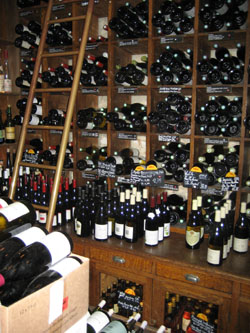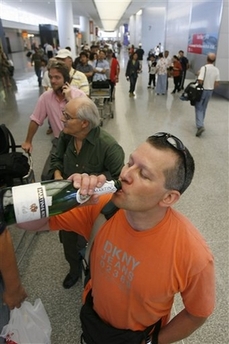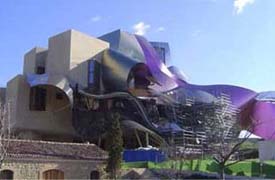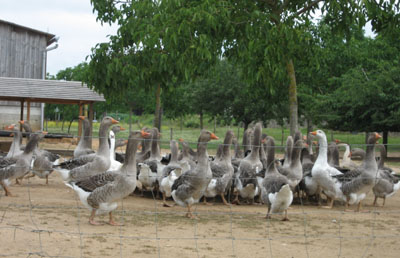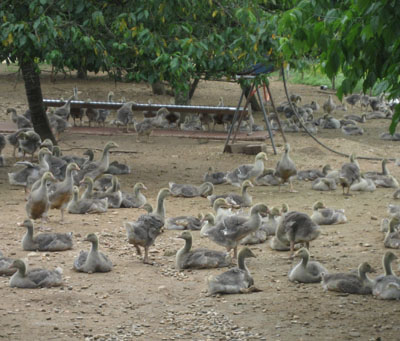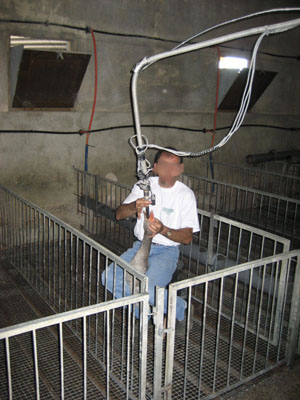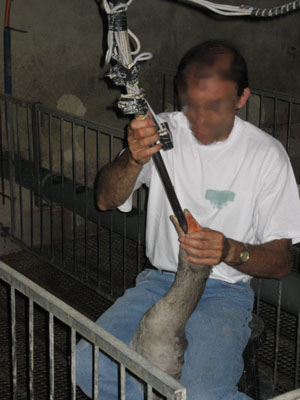Dr Vino's wine blog
wine talk that goes down easy
Caves Auge, the oldest wine shop in Paris
Credited with being the second oldest wine shop in Paris, Caves Augé is on Boulevard Hausmann. It’s not sandwiched between the big department stores on this famous street, but instead it is down the boulevard, around the traffic circle and on the less touristy, more neighborhoody, end of the grand boulevard.
The store is known for stocking many “natural†wines, particularly from the Loire, as well as older vintages from Bordeaux and beyond. Many of the producers represented are not exported to the US, which makes it a rewarding exploration for the visiting American wine geek. Tons of boutique bottlings of armagnac, cognac, sherry, vodka and other spirits cluster in one corner. Even though wine treasures abound in the small shop, not everything is beyond the reach of the budgets of mere mortals as there are many interesting wines available under $20.
But the wines may be beyond the physical reach of customers. The small shop is packed with excellent French wines. And I mean packed. The display tables are laden with their bounty and on the walls, wines are shoved into bins. I dared remove a wine from Provence to inspect the label and Marc, the store manager, barked at me in French from across the store “I’d prefer if you looked with your eyes and not with your hands.†Ah, a customer service flashback to 1850.
One reason to go to Caves Augé is when you don’t actually have to be in the cramped store (being scolded). During the spring and the fall, the store recruits many producers to come and pour their wines for customers. According to those who have been, it is a great event, casually sipping on the grand boulevard on a weekend afternoon, with some of the most interesting independent wine makers in France. Be sure to check with the store to see if your visit coincides with one of these days.
Caves Augé
116, Boulevard Hausmann, Paris 75008
Tel: 01.45.22.16.97
Open 9 AM – 7:30 PM. Closed Sunday and Monday mornings.
Manager: Marc Sibard
 tags: wine | Paris wine shops | France travel
tags: wine | Paris wine shops | France travel
America’s greatest security threat?
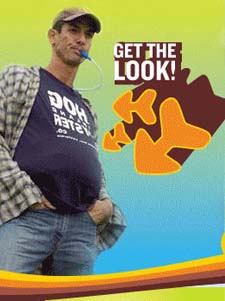
Tired of the TSA keeping you from your wine? Don’t chug, sip in style (and silence) with the beer belly! Solve your problems of liquid deprivation on flights AND transporting that cult cab back from Napa all in one.
Caution, use of the beer belly runs the risk of a frisk (or worse). Nor is it recommended as a decanter.
Photo caption: have your say with the TSA
What is your caption for this photo? Post your comments below
Image credit: AP.
 tags: wine | airport security
tags: wine | airport security
Reader mailbag: traveling to Spain
For spring break I will probably go to Spain since one of my friends will be there next year on a Fulbright. Some mutual friends who like wine are seriously considering doing the trip with me. So let me ask you for recs on Spanish wine regions that would be nice to visit in March! My colleague will be based in Madrid but I’d have about 7-10 days so could get out and about a bit.
Shazza in London writes:
Any tips for travel in Rioja? I’ll be there in October.
* * * *
If I were vactioning in Spain, based in Madrid and interested in seeing Spanish wineries, I might be tempted to go to Ribera del Duero since it is a little closer and a very exciting region. In fact, the whole Duero/Duoro region is fascinating, but I’ll post more on that in October.
Visitng the grande dame La Rioja could also be good. At least one thing makes traveling there exciting now: a new museum/winery extravaganza designed by Frank Gehry. I saw a model of it at the MOMA exhibit earlier this year about New Spanish Architecture. But as of September 17 it will be open to visitors. I doubt it will do for tourism in La Rioja what Gehry’s Guggenheim did in Bilbao (the world has had a whole lot a Gehry since then) but it will certainly motivate some people to check out this wine region.
Decanter magazine recently described Gehry’s having “designed the roof of wave-shaped titanium sheets in homage to the flowing skirts of Flamenco dancers.” Um, I sincerely hope that is not the case since flamenco is from Andalucia, all the way on the other side of Spain. Maybe Gehry had already had a little too much tempranillo.
So where to visit? (town name in parentheses)
Marques de Riscal (Elciego): Leading producer in the modern style and with the Gehry museum/hotel/spa, why not schedule a tour and a vinotherapy treatment.
Muga (Haro): the classic “old school” producer was brought, the story goes, a bottle of Napa cab by its importer and told to replicate it. Hence Torre Muga, their high-end wine. Otherwise a traditional producer. Try the Prado Enea as well as one of the whites.
Lopez de Heredia (Haro): Founded in 1887, they still use traditional methods. Very cool. Definitely try a white.
Marques de Murrieta (Logrono): Old oak barrels and stainless steel can be seen here in this atmospheric castle; try the Castillo de Ygay, red and white.
CVNE (Haro): Old company that got a new winery in 1989 with gravity moving the wine from one stage to the next.
Granja de Nuestra Señora de Remelluri (Labastida): A newer producer that is a Parker fave; very pretty location.
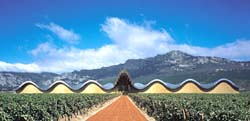
Ysios (Laguardia): If you haven’t had your fill of wineries designed by world-class architects, then check out this futuristic wave-like winery, designed by Santiago Calatrava. Now part of Pernod-Ricard.
With all of these wineries, it’s best to plan ahead and reserve for a tour if necessary. And surf on over to Catavino and drop Ryan a line and see what he has to say.
What are some of your favorite spots in La Rioja?
Send in your questions.
 tags: wine | wine travel | Spain | Rioja
tags: wine | wine travel | Spain | Rioja
La Derniere Goutte, Paris
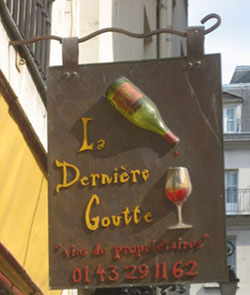
American wine geeks will feel at home at La Derniere Goutte. And it’s not because the name—the last drop—evokes an American ad campaign of a bygone era. It’s thanks to the fact that the owner speaks perfect English, since he is an American.
Juan Sanchez started his first wine shop in Paris 13 years ago in the charming streets of the Latin Quarter. After three years at one location he moved around the corner and started La Derniere Goutte. He has been sourcing wines from boutique producers ever since.
The small, climate controlled shop has a great selection of wines from independent growers particularly from the Languedoc and the Rhone. Many of the growers practice wine making that uses little intervention in the vineyard and in the winery.
And many of the producers aren’t imported to the US so you can keep WAY ahead of the Jonses. Have you ever wanted to try a champagne from Anselme Selosse for example? Juan has several as well as other champagnes made by the growers themselves (not the norm in Champagne where the big houses prevail). It’s a good thing he offers a tax refund of 13 percent for purchases over 120 euros.
Beyond simply having great wines, Juan and his staff make it easy for you to actually buy them on a tight travel schedule since they’re one of the few Paris (wine) shops open on Sundays. And oh yeah, if you’re local, they deliver too. How about that for convenience!
6, rue de Bourbon le Chateau, 75006 Paris
tel : 01 43 29 11 62
* * *
Juan is also a partner in the restaurant Fish, just around the corner on rue de Seine. Located in an old fishmonger’s store with ornate tile work on the façade, the food and service on the inside are just as refreshing as the air conditioning. We enjoyed the Domaine Roquefort rose from Provence (find this wine), which is available by the glass, carafe, or bottle. The friendly staff pour natural wines from the list and would no doubt welcome naturalistas seeking glass when the restaurant is not in full swing. You may even see Juan there after the shop closes.
A bit of trivia: directly across the street from Fish is a sandwich shop called Cosi. They bake their own flatbreads in the oven and offer a menu of light fare. Sound like the publicly traded American company by the same name is following Starbucks and making inroads into France? Actually it is the other way around in this case. This location spurred American investors to buy the rights and turn it into a hugely successful business in the states.
Fish, La Boissonnerie, 69, rue de Seine 75006 Paris. Tel : 01 43 54 34 69
Goose gitmo
[Caution: potentially disturbing photos follow the text]
Foie gras has emerged as a searing flashpoint in America where the Chicago city council has banned it and the California legislature has told the two resident producers to leave the state. Their logic is one of animal rights: cruelty to geese and ducks through force feeding that enlarges their livers to ten times the normal size.
I had abundant opportunity to sample foie gras while I was in the Dordogne region of France last month. But beyond simply eating it, I could see how it is made since it is one of the main agricultural products of the region. The characteristic low-slung, windowless barns that are the sites of the force feeding punctuate the rural landscape.
An American might suspect the barns to be underground bunkers or out of view as a refuge against rampaging hordes of activists from the animal rights group PETA. In fact, many producers hang signs to encourage visits, motivated in part by the high profit margin of selling directly to the consumer. I stopped by one producer who had a small sign in the window to his sales room: gavage 11:00 AM and 6:00PM.
Gavage is the process of force feeding the geese during the last month of their lives. I was intrigued that the producer would invite us into this goose gitmo. Did I have the stomach to see such a controversial practice in action? The rest of my family opted for a swim. I returned to the farm at 6 PM.
The geese were distributed in two large, open fields. The fluffy young ones were on one side. At about eight weeks old, they are moved to the other field for the final month before heading to the gavage barn. These were Toulouse geese, gray in color with darker plumage in the wings, a white undercarriage, and an orange bill and orange feet. The older ones already had a formidable waddle in the low-hanging bellies that almost touched the ground.
The several hundred geese in both areas had abundant food and water and could eat at will. They were outside and could roam freely. Their heads were bobbing up and down out of the water trough on the hot day. And they were loud. I hadn’t heard this much honking since I left Manhattan.
Two French couples (and a pet dog) had turned up as well and at about 6:20 the farmer arrived to lead us around. He was very open in describing the process and answering questions. One of the others in the group asked about American protests and the farmer said that he didn’t really care since none of his sales went to America. All of his sales were direct from of his shop adjacent to the large goose pastures.
Further, he said that French media coverage of American boycotts and bans devastating the industry was overblown since only four percent of French foie gras was exported to the US. Unlike cognac, which the French make for the rest of the world with 95 percent of production exported, the French tend to make foie gras for themselves, making 70 percent of the world’s production and eating 85 percent of it (Hungary helps fill the gap). According to a well-written story by Mike Steinberger in the Financial Times, the French National Assembly declared foie gras “a cultural and gastronomic patrimony protected in France” last October.
The farmer then picked a goose by the wings and we then moved into the gavage barn, which was mercifully empty and surprisingly dark. Although there were still geese on the farm, the farmer didn’t do gavage during July and August to take a vacation for himself and the staff.
After three months in the open, the geese are escorted to the gavage barn and put twelve per pen. He explained that they are gregarious and that’s why they are kept together. They are then force-fed four times a day with a machine operated by a person in the pen with the geese. The food is corn, starchy, empty calories good for fattening he said. This stands in contrast to the balanced diet that the geese received while they were outside.
The farmer said that the geese do not have the ability to swallow, which explains why their heads bobbed at the water trough outside: they filled their mouth and gravity took the water down. Nor do they have a gag reflex, which is apparently linked of the ability to swallow. No peristalsis, no reverse peristalsis. He said that conditions were worse for ducks (whose livers are also valued and he does not have) since they are smaller and have less of a group mentality they are force fed mechanically and kept in smaller pens with more per shed.
Whether or not having a feed tube shoved down the throat causes pain to the birds, the fact that they are kept in the dark for this last month of their lives, fed four times a day and rapidly put on weight cannot be pleasant. In the end they are slaughtered and a new group is brought in.
What’s interesting from a socio-economic point of view is that the nature of the French farm is changing. The farmer told us that a generation or two ago, a farmer would have a limited number of diverse livestock and would force-feed a goose in time for Christmas. But now there is increased specialization among farmers. He started only a decade ago. His neighbors around him grow only corn.
Back in America, what’s motivating the foie gras protesters and the legislators? Is foie gras production really any different than the inhumane conditions that exist for veal? Or other livestock from poultry to hogs to cattle? (As vividly shown in Michael Pollan’s The Omnivore’s Dilemma or Eric Schlosser’s Fast Food Nation among other places) Will osso buco be coming into the sights of legislators?
Probably not. The trouble with arguments that suggest foie gras is the thin edge of the wedge is that it is just so thin–the amount of foie gras consumed in America is miniscule. And that’s a part of what appeals to activists and legislators alike: it’s easier to take on the three American producers of foie gras than it is the National Cattlemen’s Beef Association.
But it is instructive—nay, essential—to know where food comes from. That’s why I signed up for the gavage tour. Meat, while it’s alive is a lot different from meat in a confit jar or under plastic wrap in the supermarket. If everyone were more aware, more people might choose to be vegetarians. Or not. After all, Michael Pollan still eats meat and Eric Schlosser still eats hamburgers. But it would be an informed choice.
Lavinia, French for wine convenience
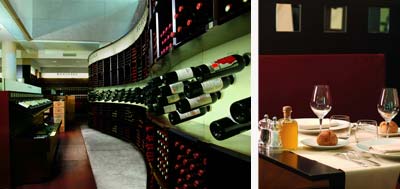
If you are in Paris looking for a wine from the Etats-Unis, New Zealand, or even Brazil, your home to one-stop shopping convenience has a name: Lavinia.
Sprawling over a climate-controlled three floors, the store is the most New World in its orientation in all of Paris. Opened in 2003 after its owners cut their teeth on locations in Barcelona and Madrid, the store stocks 6,000 wines, hundreds of spirits, a significant selection of wine books in French and English, and a handsome tasting bar and restaurant. And with copious amounts of staff, the customer service is as refreshing as the air conditioning.
Consider it a must-stop for wine geeks, whether for ex-pats or locals who are stuck in a rut or visitors who are looking for the best of French wines.
The entry floor has many wines stuck neck first into a display with helpful rings around them indicating a good value, organically grown, best seller, or a seasonal selection. One section suggests wines paired with various foods. They offer a sample of a wine or two a week, poured in a glass (not plastic!).
This floor houses the wines of the world, from Argentina to Spain and Tuscany to Napa. A panel on the wall said “Cuba” and I was intrigued–since my home country has an embargo against products of the island, this was my first chance to try a wine from the island more known for tobacco than grapes. Alas, it was not to be since the wine, once stocked, was no longer available (a testimony to its poor quality a staff member told me).
Upstairs is the library, a huge array of armagnacs and cognacs, and the swanky bar/restaurant. Their attitude toward customer service is such that the whole store becomes the wine list: each wine in the store can be consumed at the bar for the same price as in the store, which makes it the most diverse wine bar in Paris (open til 8 PM).
Downstairs is all French, all the time. There is a cooler storage area for not just e expensive and rare wines but also some affordable “natural” wines that need a little more TLC. This area holds perhaps the most appeal for visitors to Paris looking to pick up some of the bounty of France.
If the sumptuous selection is too much for you to carry home, they deliver! (a concept, essential in Manhattan, which is still in its infancy in Paris) And for non-EU visitors who start swiping the plastic with vigor, the store offers a 13% tax refund on purchases over 300 euros–though it will require getting to the airport early to claim it.
The selection here of wines from the world can’t be beat in Paris. If you are sold on the business model, then it can be yours: a sign in the window says “franchisees wanted.”
Lavinia, 3-5 Boulevard de la Madeleine, 75001 Paris. 01 42 97 20 20
www.lavinia.fr
 tags: wine | wine shops | wine stores | Paris
tags: wine | wine shops | wine stores | Paris
France travel tips
If you are returning your rental car to the Bordeaux train station, drive past the main door of the station, turn left over the tracks, then left again on the other side. There. Now somebody told you. Nobody told me and there are no signs. Better yet, if you are traveling with at least one other person, drop them off at the main door with all the luggage–there are no luggage carts to traverse the vast parking lot. Oh, and no elevators inside the train station.
Use your ATM card: my credit card charges a 3% foreign transaction fee vs 1% for the ATM card. Sure $20 on every $1000 isn’t that much but hey–it’s two bottles of Dr Vino picks!
If you’re in Paris during a heatwave, take the bus. No AC in the metro means that it is an odorific, heatastic experience. At least in the bus you can open the window two or three inches. Or better yet, splurge for a taxi (no charge for extra passengers) and get some AC–maybe.
Have a pique-nique on a shady park bench. Any decent boulangerie will have (pre-made) sandwiches that will knock the snot out of any Subway 12 incher. If you’re traveling with kids under 10, the best spot for this pique-nique is the jardin du Luxembourg with its pony rides, playground, puppet shows, and pond with sail boats.
Take a couple of large ziploc bags with you when you go. That way when you buy some yummy, transportable foods to bring home, it won’t get all over your luggage the way my AOC green lentils spilled in mine. My stews this fall will have a nice aroma de luggage.
Drink local. Many local wines offer compelling price to quality ratios. However, many of them stink. Only one way to find out.
If you fly home on American Airlines from CDG, have an e-ticket, and are a US citizen, bypass the check-in lines and head straight for the short self-check-in line in the middle. Nobody knows about it and it’s totally legit. It only took me 45 minutes in the other line to find this out.
And if you’re in Paris, be sure to hit some of the cool wine shops and wine bars I will be posting about over the next few days!
 tags: wine | French travel tips
tags: wine | French travel tips
